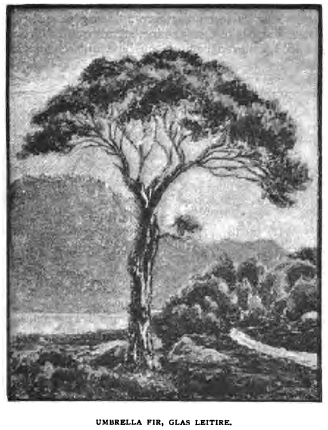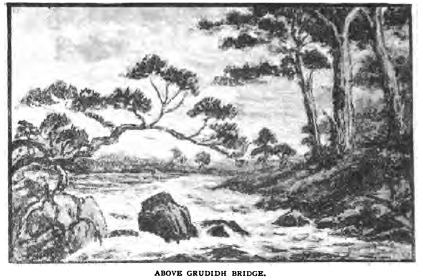LEAVING the village of Kenlochewe we see the Torridon road striking off
to the left. A mile further on the road crosses a burn, whose bed is
composed of fragments of white quartzite washed down from the rocky
heights of Beinn Eighe.
Further on to the right is the farm of Tagan, a
short distance from the road. Beyond and above it notice the precipitous
spur of Beinn a Mhuinidh, called Bonaid Donn, and the waterfall (Part
III., chap, i.) on its steep face. In the distance, looking up the glen
between the Bonaid Donn and Slioch, may be observed a curious hill,
similar to one noticed in the last stage; the outline is a silhouette of a
man's profile facing skywards.

As we approach the strand of
Loch Maree the woods of Glas Leitire begin, and now the interest
heightens. Wildfowl may often be seen about the marshy ground at the head
of the loch. On the left a spur of Meall a Ghuibhais, with wild ravines,
comes near the road, and the mingled foliage of the firs and birches
enhances the charms of the scene.
Ru Nohar, with its little pier or
jetty, is soon reached and passed. Were it not for the great convenience
of the steamer on Loch Maree, and the new beauties it unfolds, most people
would think it out of character with the wild surroundings.
Passing
through the Glas Leitire woods roedeer and black game may often be
observed. One or two fir trees are of umbrella-like form {see
illustration).
Her most gracious Majesty Queen Victoria, in "More Leaves
from the Journal of a Life in the Highlands," describes this part of the
route in the following graphic language :—
" The windings of the road
are beautiful, and afford charming glimpses of the lake, which is quite
locked in by the, overlapping mountains. There are trees above and below
it, of all kinds, but chiefly birch, pine, larch, and alder, with
quantities of high and most beautiful heather and bracken growing
luxuriantly, high rocks surmounting the whole. Here and there a fine
Scotch fir, twisted, and with a stem and head like a stone-pine, stands
out on a rocky projection into the loch, relieved against the blue hills
as in some Italian view."

The road is almost level
until a mile beyond the bridge of Grudidh. Before we reach this bridge the
wild Glen Grudidh, which is one of the most telling features in the
scenery of Gairloch, has come in view. Its noble centre-piece is the fine
peak of Ruadh Stac of Beinn Eighe, which is the highest summit in Gairloch
parish, and attains an altitude of 3309 feet. The smaller peak beyond it
acts as a foil to set off its grandeur.
There are fine old fir trees
near Grudidh bridge; in combination with the rocky course of the Grudidh
water they supply a series of splendid subjects for" the artist's brush
{see illustrations).
A mile further Eilean Grudidh is seen in a little
bay. This island is mentioned on pages 21, 24, and 43, and is described on
page 98. It was many centuries ago a stronghold of the MacBeaths, and
afterwards of the MacLeods.
The road here is wild and dreary. Her
Majesty speaks of it thus:—"Part of the way the road emerges altogether
from the trees and passes by a mass of huge piled-up and tumbled-about
stones, which everywhere are curiously marked, almost as though they were
portions of a building, and have the appearance of having been thrown
about by some upheaving of the earth."
Some rocks by the roadside
exhibit fine examples of groovings and scratchings effected by ice in the
glacial epoch.
The rocky hill along the base of which the road passes is
Coinneachadh Beag (1830 feet), a spur of Beinn a Chearcaill. The English
of Coinneachadh is a "meeting-place;" it does not require a great flight
of imagination to picture the famous Hector Roy meeting his warrior forces
on the slope of this wild hill to plan dire vengeance against the
blood-stained M'Leods. Two miles beyond Grudidh bridge the road ascends
and climbs the shoulder of Coinneachadh Beag, which runs out in a low
promontory almost dividing Loch Maree. The highest part of the road is 130
feet above the level of the loch, and affords a fine view of Letterewe at
the other side, and of the hills beyond it, on which is the place called
to this day the Hollow of the son of Black John. An account of the death
of this Macleod at the spot which bears his name will be found on pages 43
and 44. Descending the western side of the hill we reach the hamlet of
Talladale, at the foot of the Talladale river, which comes from Strath
Lungard. Here are picturesque trees. On the right is an old lime-kiln, and
a little further on the same side the keeper's house. In the corner of the
first field on the left were formerly ironworks (see page 92). John Roy
Mackenzie, fourth laird of Gairloch, died at Talladale; his piper, Rorie
Mackay, spent part of his life here, and here Rorie's son, the celebrated
" Blind piper," was bom. Crossing the bridge, notice the stony bed of the
small river and the steep end of Beinn an Eoin in the distance to the
right. Almost immediately we reach
The Loch
Maree Hotel, Talladale.
This hotel was built in 1872, and is
beautifully placed in a sheltered bay, backed by a hill called Sron a
Choit, 970 feet in height, whose rocky tops rise above most beautiful
natural birch woods. A small pier or jetty was erected here in 1884 as a
landing-place for the steamer. There are good stables, in connection with
the larger posting establishment at Gairloch. Mr M'lver, of Achnasheen,
has also a stable not far from the hotel for the horses which work his
mail-cars. The hotel, which has lovely views of Slioch and the islands of
Loch Maree, contains a spacious coffee-room, a private sitting-room, and
near a score* of bedrooms. There is a telegraph and post office, and a
supply of boats and gillies waiting for engagement. Visitors here have the
privilege of fishing some of the best parts of Loch Maree. The sport
varies in different years, and is frequently very good. Part IV., chap,
xvii., is devoted to the subject of angling in Loch Maree, which may be
said to continue from the middle of May to the middle of October. The
greatest rush of anglers is from the middle of August to the middle of
September; I recommend those who can to come earlier in the season.
The
Loch Maree Hotel has been distinguished by the visit of Her Majesty Queen
Victoria, who occupied the house from 12th to 18th September 1877. Her
Majesty narrates the incidents of this visit very fully in her book
already quoted, to which I beg to refer the tourist. Her Majesty has the
following entry on the day of her departure :—"Got up early and
breakfasted at half-past eight, and at a quarter to nine we left with
regret our nice cozy little hotel at Loch Maree, which I hope I may some
day see again." This visit of our most gracious Sovereign evoked the
reverential ioyalty of all in Gairloch, and the popular wish still
cherished among us may be accurately expressed in the old words,—
"Will ye no come back agen?"
In commemoration of the visit of Her
Majesty, Sir Kenneth Mackenzie caused an inscription to be carved on a
boulder of the "Torridon red" sandstone, which stands opposite the front
door of the hotel. The inscription is in Gaelic, and is as follows :—"Air
an dara latha-deug deth mhios meadhonach an fhoghair, 1877, thainig Ban-Righ
Bhictoria a dh' fhaicinn Loch-Maruibhe, agus nan criochan mu'n cuairt.
Db'fhan i sea oidhche s'an tigh-osda so thall; agus 'na caomhalachd,
dheonaich i g'um biodh a' chlach so 'na cuimh-neachan air an tlachd a
fhuair i 'na teachd do 'n chearn so de Ros."
The following is a literal
translation :—"On the twelfth day of the middle month of autumn 1877 Queen
Victoria came to visit Loch Maree and the country round it. She remained
six nights in the opposite hotel, and, in her kindness, agreed that this
stone should be a memorial of the pleasure she experienced in coming to
this quarter of Ross."

